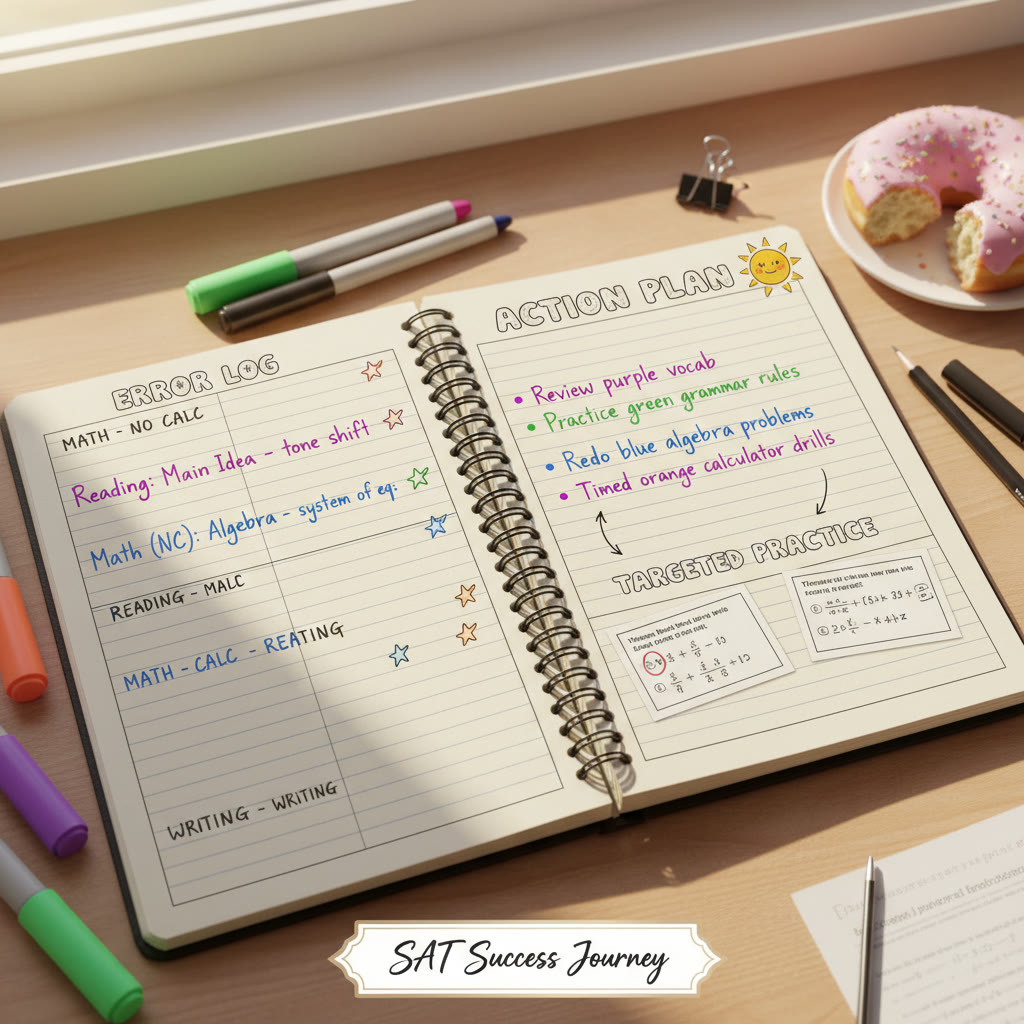Why Practice Tests Matter — Especially Right Before the SAT
There are plenty of study tools: flashcards, grammar drills, vocabulary lists, and targeted math problem sets. But when the calendar suddenly reads “Test: two weeks away,” nothing gives you a clearer read on where you stand than a full-length practice test. Practice tests do more than measure — when used correctly, they guide your last-minute strategy, sharpen pacing, and expose weak spots you can realistically improve.
The difference between doing practice tests and using them effectively
Taking practice tests as a checkbox exercise — sit, finish, sigh — is a missed opportunity. An effective practice-test routine transforms raw questions into a feedback loop: take the test, review every question (right and wrong), adjust your study plan, and repeat. The quality of that review is what moves your score, not just the number of tests you take.
When to Start Taking Full-Length Practice Tests
Timing matters. Too early, and you won’t get targeted insights; too late, and you won’t have time to act on them. Here’s a sensible timeline:
- 6–8 weeks out: Take one baseline practice test to identify broad weaknesses. This sets a baseline.
- 3–4 weeks out: Increase to one practice test per week while focusing on targeted practice derived from your baseline.
- Last 1–2 weeks: Shift to 2–3 full practice tests each week, with careful review and simulated conditions.
This cadence gives you enough measurement without burning out. If time is very limited, prioritize high-quality reviews over sheer quantity.
How to Simulate Real Test Conditions
One of the biggest advantages of a practice test is learning how your brain behaves when you’re on the clock. Simulate the testing room as closely as possible so that you reduce surprises on test day.
Checklist for realistic simulation
- Find a quiet space similar in size and lighting to a classroom.
- Use a printed test and a mechanical timer or phone timer on a table — no pausing.
- Wear a watch or set a visible clock for pacing checks.
- Keep the exact break schedule the SAT uses, and take the break at the right time.
- Eat the same kind of pre-test breakfast you plan to eat on test day.
- Use only allowed materials (calculator for permitted sections, no notes).
Simulating conditions builds mental endurance and reduces test-day anxiety. When your brain has already endured three full timed sections under similar constraints, the real SAT feels less like an unknown.
Before You Start: Set Clear Goals for Each Practice Test
Want better scores or just more confidence? Both are legitimate. But an aimless test gives weak data. Define one or two goals before every practice test:
- Validate pacing in Reading: can you comfortably finish passages in the time allotted?
- Target accuracy in the Math calculator section for algebraic word problems.
- Practice focus in the Essay (if applicable) — structure, thesis, and evidence use.
- Test a specific strategy: skipping difficult question types or marking and returning.
With small, testable goals, your review becomes purposeful. For example, if your goal is pacing, your review will focus on time logs and question timing rather than content errors alone.
How to Review a Practice Test — The Most Important Step
Reviewing is where improvement happens. A full review takes time, but it’s worth every minute. The idea is simple: don’t just mark answers right or wrong; understand why each error happened and what you will do next time.
A structured review process
- First pass — Triage (30–60 minutes): Quickly mark questions as easy, avoidable mistakes, careless errors, or conceptual gaps.
- Second pass — Deep analysis (1–2 hours): For each wrong answer, write a short note: the misconception, the missing skill, and the correction method.
- Third pass — Action plan (30–60 minutes): Translate your notes into practice: problem sets, grammar rules, or pace drills.
Example of a mistake log entry:
- Question: Algebra word problem about rate.
- Error type: Set-up error — used equation x + y = distance instead of x + y = total rate.
- Fix: Review rate equations; solve 5 practice rate problems; explain setup aloud.
Common Error Types and How to Fix Them
Most mistakes on practice tests fall into predictable categories. Recognizing them quickly helps you choose the right remedy.
Careless slips
These are avoidable errors — misreading numbers, misplacing negative signs, or missing small words in Reading. Remedies include slowing down on the first read, underlining key terms, and adding short checks before bubbling answers.
Timing issues
Often not conceptual errors but time-management failures. Solutions: practice with a stopwatch, do section-level timing drills, and master quick elimination techniques for multiple choice.
Concept gaps
These are true knowledge gaps — unfamiliar grammar rules, shaky trig identities, or faint knowledge of evidence-based reading strategies. Address them by focused lessons, targeted problem sets, and short daily reviews.
Strategy failures
Sometimes errors are due to approach — guessing too early, not annotating passage structure, or trying to do every problem blind. Test different strategies on practice tests and keep the ones that reliably reduce errors.
Use Data, Not Just Feelings
Many students rely on intuition and gut feelings after a practice test: “I felt good about it so I must have scored well.” But feelings are unreliable. Use numbers.
Collect these metrics every test
- Section raw scores and estimated scaled scores.
- Time spent per question (average and for outliers).
- Question-type breakdown: algebra, geometry, sentence structure, command of evidence, etc.
- Proportion of careless vs. conceptual errors.
Recording this data creates a map. If your Reading score is erratic but Math is steady, you’ll know where to concentrate in the next study block.
Practical Example: Turning One Practice Test into a 10-Point Gain
Here’s a realistic, specific example of how a student can convert one practice test review into measurable growth.
- Baseline: Student A takes a practice test and scores 1100 (Reading 540, Math 560).
- Diagnosis: In Reading, Student A loses points on main-idea and inference questions; in Math, mistakes are split evenly between careless errors and two weak algebra topics.
- Action plan over next week:
- Reading: Do 10 inference-focused passages with detailed explanation of correct answers; practice paraphrasing main ideas.
- Math: Drill system of equations and function notation for 45 minutes, and start a daily 15-minute accuracy drill to reduce careless errors.
- Follow-up test: After targeted work and a realistic practice test simulation, Student A scores 1110–1120 — a 10–20 point gain, driven by fewer careless errors and improved inference accuracy.
Designing a Last-2-Weeks Practice-Test Schedule
The last two weeks are about consolidation and confidence, not learning brand-new topics. Here’s a sample structure you can adapt to your life.
| Day | Activity | Time Commitment | Goal |
|---|---|---|---|
| Day 14 | Full practice test under simulated conditions | 4 hours + 3 hours review | Baseline measurement; identify weaknesses |
| Day 12 | Targeted practice (focused on Week 2 weaknesses) | 1.5–2 hours | Repair conceptual gaps |
| Day 10 | Section-timed drills (Math & Reading) | 90 minutes | Improve pacing and stamina |
| Day 8 | Full practice test | 4 hours + 3 hours review | Test strategy tweaks |
| Day 6 | Focused concept sessions + light review | 2 hours | Reduce error types |
| Day 4 | Mini full test (no essay) with strict timing | 3 hours | Final pacing practice |
| Day 2 | Light review, formula sheet, mental prep | 60–90 minutes | Reduce anxiety and sharpen focus |
| Day 0 (Test Day) | Warm-up (15–30 minutes), arrive early | 30–60 minutes | Be calm and ready |
This plan balances full tests with targeted practice and recovery days. If you have limited time, reduce the number of full tests but keep the review intensity.
Pacing Strategies You Can Test Immediately
Pacing is a frequent score-sapper. Two students with identical content knowledge can score very differently because of pacing habits. Try these practical experiments in your next practice test.
- Chunking: Allocate time by passage or question blocks rather than trying to micro-manage every question.
- Early triage: Quickly skim and mark hard questions to return to after clearing easier ones.
- Answer-first for Math: If you can estimate or eliminate answers fast, use backsolving to save time.
- Set micro-checkpoints: After every 10 questions, glance at time remaining and adjust pace.
During practice tests, record how often you used each strategy and whether it reduced time pressure. That data guides what to do on test day.
How to Avoid Burnout in Intense Practice-Test Periods
More practice tests won’t help if you’re too tired or anxious to learn from them. Protect your energy with these small but effective habits:
- Sleep: Prioritize consistent nights of 7–8 hours; your brain consolidates learning while you sleep.
- Nutrition: Eat balanced meals and have a test-day snack that you’ve practiced with before.
- Short breaks: Schedule short mental breaks after heavy review sessions to let information settle.
- Mindset work: Visualize success and practice breathing techniques to reduce test-day anxiety.
Quality of practice beats quantity. It’s better to take two well-reviewed practice tests than five rushed and poorly analyzed ones.
How Tutors and Personalized Help Can Amplify Test-Usefulness
Sometimes self-review hits a wall: you know there’s a recurring error but can’t quite articulate the misconception. That’s where personalized tutoring helps. A good tutor can pinpoint your thought patterns, model step-by-step corrections, and help you make a realistic, focused plan in the last weeks.
Sparkl’s personalized tutoring and benefits — like 1-on-1 guidance, tailored study plans, expert tutors, and AI-driven insights — naturally fit here. When you’re working through practice-test reviews, a tutor can accelerate the “why” behind mistakes, suggest precise drills, and keep you accountable without adding stress.
Last-Minute Test-Day Checklist
The day before and the morning of the SAT should be calm, deliberate, and routine. Here’s a concise checklist so nothing surprises you.
- Print your admission ticket (or have digital confirmation as required).
- Pack two No. 2 pencils, an approved calculator with fresh batteries, ID, snacks, and water.
- Lay out comfortable clothes and a watch for pacing.
- Plan your route to the testing center and arrive early.
- Do a 15–20 minute light warm-up: a few grammar questions and one short math review; nothing taxing.
- Practice two deep breaths and a short grounding exercise before the test begins.

Realistic Expectations: What’s Possible in the Final Weeks
Be honest with your goals. Major leaps (50+ points) are possible but less common in the final week unless you resolve specific, high-value errors. Most students see incremental gains: 10–30 points from reducing careless errors and improving pacing, and possibly more if they plug a clear conceptual gap. The key is concentrated effort on the highest-return actions identified by practice tests.
What to watch out for
- Avoid introducing brand-new, complicated strategies in the last 48 hours.
- Don’t obsess over a single practice-test score — look at trends across multiple tests.
- If anxiety spikes, scale back the intensity and focus on confidence-building routines!
Final Thoughts: Make Each Practice Test a Smart Investment
Practice tests are your most powerful diagnostic tool in the weeks before the SAT. They tell you where you are, where you can realistically improve, and what to prioritize. Use them under simulated conditions, review rigorously, record clear metrics, and convert discoveries into targeted practice. Protect your sleep and energy, and seek personalized feedback when you’re stuck — a tutor can turn repeated errors into solved problems quickly.
Most importantly, treat practice tests as a conversation with the exam. Each test speaks; your job is to listen, learn, and respond thoughtfully. With focused use of practice tests and a little strategic help — perhaps from Sparkl’s personalized tutoring when it fits your needs — you’ll head into test day calmer, keener, and more prepared to get the score you want.

Quick Checklist — Use This Before Every Practice Test
- Set 1–2 clear goals for the test.
- Simulate real test conditions (timing, breaks, materials).
- Record raw scores and time-per-question.
- Do a triage review, deep analysis, and create an action plan.
- Apply targeted practice, then repeat the test cycle.
Good luck — and remember, practice tests are not just a trial run; they are the roadmap to the score you want. Use them well, and they’ll return the favor.













No Comments
Leave a comment Cancel